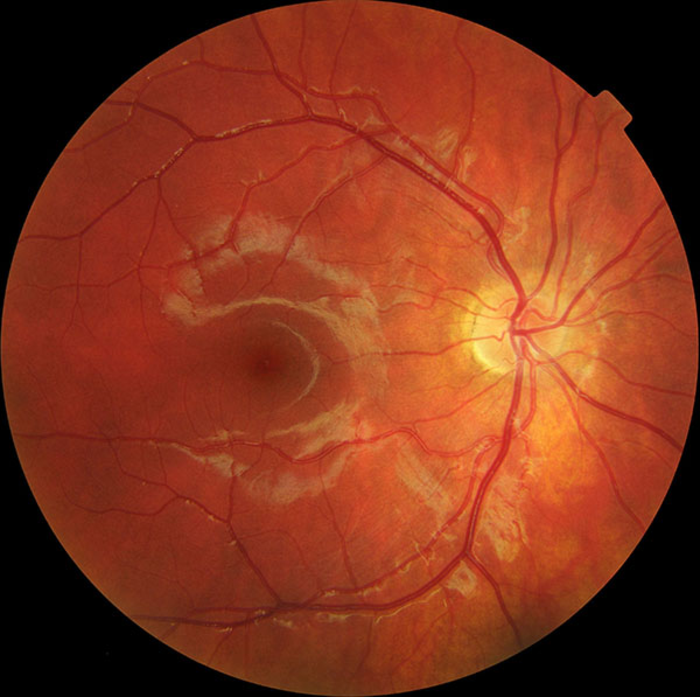Article
UCSD receives major gift to focus efforts on macular dystrophy
Author(s):
The Viterbi Family Department of Ophthalmology and Shiley Eye Institute, both part of UC San Diego Health, received funding from the Nixon Visions Foundation that will support studies of the PRPH2 gene linked to macular dystrophy and boost stem cell research aimed at developing early diagnosis and a cure.
Macula dystrophy can occur when photoreceptor cells comprising the retina at the back of the eye progressively become impaired and unable to function fully, leading to loss of full vision and perhaps blindness. (Image courtesy of Ralf Roletschek)

The Nixon Visions Foundation, led by philanthropists Brandon and Janine Nixon, has given a significant gift to the Viterbi Family Department of Ophthalmology and Shiley Eye Institute, both part of UC San Diego Health, to launch the Nixon Visions Foundation Macular Dystrophy-PRPH2 Research Fund, which will focus studies of the PRPH2 gene and related mutations and help upgrade stem cell technologies that may eventually provide a proven therapeutic remedy.
In healthy vision, a gene called PRPH2 provides instructions to make a protein called peripherin 2 (PRPH2), which plays a key role in the normal functioning of photoreceptors that detect light and color and which line the back of the eye.
When there are mutations in the PRPH2 gene, the result can be macular dystrophy, an impairment of the retina that progressively diminishes the ability to see clearly and may eventually result in vision loss. Currently, there are no effective treatments to slow or prevent the condition.
Advancing research
The Nixon Visions Foundation is also building capacity with the Foundation Fighting Blindness to further advance national and global research in this space as part of this effort.
“We are impressed with the impactful work at UC San Diego and specifically in the Department of Ophthalmology and at Shiley Eye Institute,” the Nixons said in a statement. “We believe this gift can accelerate efforts to make a tremendous impact for people with this inherited eye disease and will improve the lives of others for generations to come.”
UC San Diego Chancellor Pradeep Khosla pointed out that macular dystrophy is a challenging disease for people who have it, but noted that “UC San Diego Health has the expertise to discover new ways of treating this illness and creating a healthier world.”
“Thanks to the generosity of the Nixon Visions Foundation, we can pursue the most promising leads and follow the science wherever it takes us,” Khosla said in a statement.
Rare condition
Macular dystrophy is a relatively rare eye condition. It affects the central retina or macula, which has the highest concentration of light-sensitive cells or photoreceptors. It is different from the more common eye disease known as macular degeneration, which is often caused by age-related deterioration of the retina and macula. Macular dystrophy is associated with genetic mutations that — for no known reason — trigger degradation of retinal cells. Some forms of the disease appear in childhood; some in adulthood.
According to Shyamanga Borooah, MD, assistant professor of ophthalmology at Shiley Eye Institute and one of the investigators on the PRPH2 research project, there aren’t many viable therapies for macular dystrophy and even fewer promising leads to develop them.
“In our work we believe we’ve found one,” Borooah said in a statement. “But that work is still in its fairly early phases so for myself and my colleagues, such as Dr. Radha Ayyagari, funding like this from the Nixon Visions Foundation is crucial to understanding causes and treating the disease.”
Faculty in the Viterbi Family Department of Ophthalmology and at Shiley Eye Institute are among the leaders in basic research investigating the causes of eye disease and finding remedies. The institute is home to the Joan and Irwin Jacobs Retina Center.
“Shiley Eye Institute is at the leading edge of vision research and eyecare, and we know that macular dystrophy is a devastating diagnosis,” Robert Weinreb, MD, director of Shiley Eye Institute, chair of the Viterbi Family Department of Ophthalmology, and Distinguished Professor of Ophthalmology said in a statement. “We are confident that there is no place better to understand this illness and innovate therapies for it than UC San Diego Health.”
Patty Maysent, CEO of UC San Diego Health agreed.
“Shiley Eye Institute represents some of the finest ophthalmological research and care in the world,” she added. “We are honored to have the support of the Nixon Visions Foundation in such a tangible, meaningful way.”
Philanthropic gifts, like the one from Brandon and Janine Nixon, contribute to the Campaign for UC San Diego — a universitywide comprehensive fundraising effort concluding in 2022.
Alongside UC San Diego’s philanthropic partners, the university is continuing its nontraditional path toward revolutionary ideas, unexpected answers, lifesaving discoveries and planet-changing impact.
To learn more about supporting the excellent research, education and care taking place at UC San Diego Health Sciences, visit campaign.ucsd.edu.
Newsletter
Don’t miss out—get Ophthalmology Times updates on the latest clinical advancements and expert interviews, straight to your inbox.





